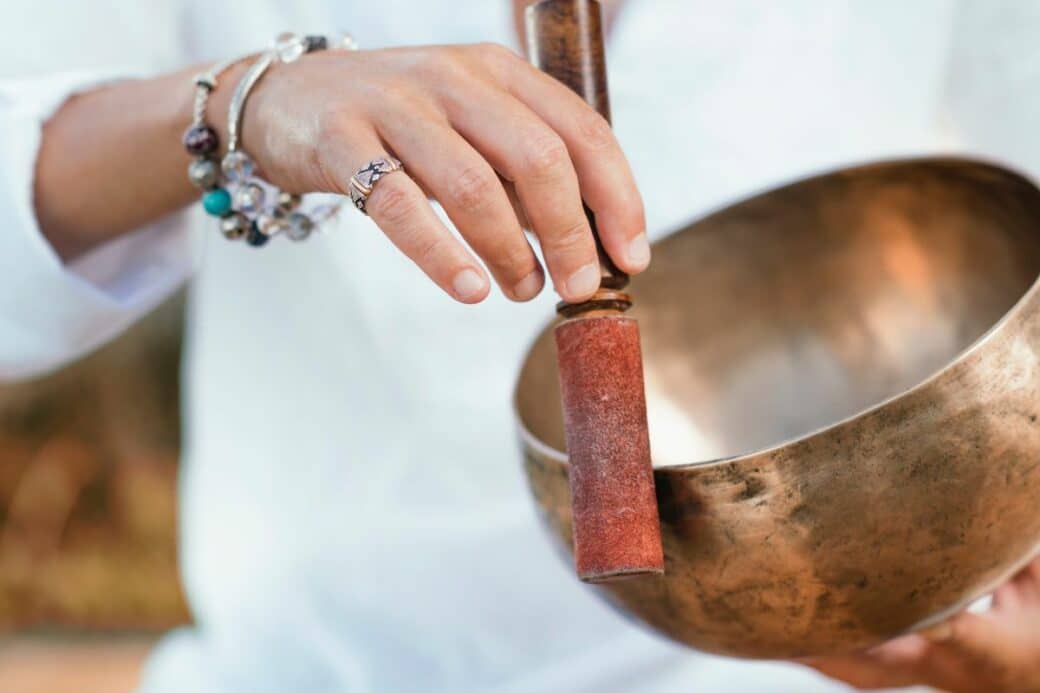Step into the world of enchanting sounds and discover the mesmerizing melodies of a singing bowl. Have you ever wondered what these ancient instruments sound like? Well, prepare to be captivated as you immerse yourself in the celestial chimes and resonating vibrations that emanate from these beautifully crafted bowls. Let the soothing tones transport you to a place of tranquility and harmony, as you explore the timeless wonders of the singing bowl’s unique and evocative sound. Get ready to unlock a world of sonic bliss as you embark on a journey to experience the captivating harmony of a singing bowl.

What Does A Singing Bowl Sound Like: Understanding Singing Bowls
History and origin of singing bowls
Singing bowls have a rich history that dates back over 2,500 years. Originating in the Himalayan region, particularly in Tibet, Nepal, and India, these bowls have deep cultural and spiritual significance. They were initially used in religious rituals, meditation practices, and healing ceremonies. Singing bowls were believed to create a sacred and harmonious atmosphere, inviting inner peace and spiritual awakening.
Materials used to make singing bowls
Traditionally, singing bowls were made from a combination of seven metals, representing seven celestial bodies: gold for the Sun, silver for the Moon, copper for Venus, iron for Mars, tin for Jupiter, lead for Saturn, and mercury for Mercury. This blend of metals was believed to enhance the bowls’ spiritual properties and resonance. Nowadays, singing bowls may also be made from crystal, bronze, or even ceramic, each material offering its unique sound qualities.
Size and shape variants of singing bowls
Singing bowls come in a variety of sizes and shapes, allowing for a range of sounds and vibrations. The most common shape is that of a hemispherical or inverted bell, with a flat or slightly rounded bottom. However, there are also cylindrical and cone-shaped bowls, each producing a distinct sound. Additionally, the size of the bowl influences the pitch and volume of the sound it produces, with larger bowls generally producing deeper tones.
How Singing Bowls Produce Sound
Physics behind the singing bowls’ sound
The sound produced by singing bowls is a result of the physical interaction between the bowl, the striker, and the surrounding air. When the bowl is struck or rubbed with a wooden or leather-covered mallet, it sets off a series of vibrations along its rim. These vibrations travel through the bowl, causing the air molecules to move and creating sound waves. The shape and materials of the bowl influence the unique characteristics of the sound, such as the pitch, volume, and quality.
Role of craftsmanship in sound production
Craftsmanship plays a crucial role in determining the quality of sound produced by singing bowls. Skilled artisans carefully shape and tune the bowls to produce specific frequencies and harmonics. The choice of materials and the precision in creating the bowl’s shape and thickness all contribute to the clarity, resonance, and purity of the sound. Each bowl is a testament to the craftsmanship and dedication of the artisans who strive to create the perfect balance of aesthetics and acoustics.
Influence of size and form on the frequency of sound
The size and form of a singing bowl dictate the frequency or pitch of the sound it produces. Larger bowls generally produce lower frequencies and deeper tones, while smaller bowls create higher-pitched sounds. The shape of the bowl’s rim can also affect the specific harmonic overtones that are present in the sound. By selecting different sizes and forms of singing bowls, one can access a variety of frequencies and create a symphony of harmonious vibrations.
Sound Attributes of Singing Bowls

Tone and pitch variations
Singing bowls offer a wide range of tone and pitch variations, allowing for diverse musical expressions. The tone of a bowl refers to its overall sound quality, whether it is deep and resonant or bright and vibrant. Pitch, on the other hand, relates to the specific frequency of the sound, determining whether it is high or low. Singing bowls can produce a full spectrum of tones, from soothing and calming to energizing and uplifting, making them versatile instruments for musical and therapeutic purposes.
Duration of sound and resonance
One of the remarkable qualities of singing bowls is their sustained sound and resonance. When struck or played, the vibrations linger in the air, creating a prolonged and immersive sonic experience. This extended duration allows the sound to envelop the listener, facilitating deep relaxation and meditation. The resonance of the bowl can also be enhanced by placing it on a cushion or holding it in the hand, allowing the vibrations to flow through the body and promote a sense of harmony and well-being.
Complexity of sonic vibrations and overtones
Singing bowls produce not only a fundamental frequency but also a range of overtone frequencies, giving the sound its rich and complex quality. These additional frequencies create harmonics that interact and blend, forming intricate patterns of sonic vibrations. The interplay between the fundamental frequency and the overtones contributes to the unique timbre and texture of the bowl’s sound. This complexity adds depth and dimension to the sonic experience, captivating and mesmerizing the listener.
Experiencing the Sound of a Singing Bowl
Sound as a sensory experience
Listening to the sound of a singing bowl is a multi-dimensional experience that engages our senses on various levels. As the bowl resonates, we not only hear the sound but also feel its vibrations in our bodies. The gentle hum of the bowl can create a sense of calmness and tranquility, transporting us to a state of deep relaxation. The sound envelops the space around us, immersing us in its soothing embrace and providing a gateway to explore our inner world.
Describing sound using analogies and metaphors
Describing the sound of a singing bowl is a delicate task that often requires the use of analogies and metaphors. Some may liken the sound to the ethereal chimes of a distant bell, while others may describe it as the soft whisper of a gentle breeze. The harmonious blend of tones and the layers of vibrations can evoke images of flowing water, celestial melodies, or even the buzzing of bees. These descriptions help convey the transcendent and magical quality of the sound that cannot be fully captured in words alone.
Variability of sound perception among different listeners
The perception of sound is unique to each individual, and the experience of listening to a singing bowl can vary from person to person. Factors such as one’s hearing abilities, musical background, and personal preferences all contribute to the way we perceive and interpret the sound. Some may find the sound deeply soothing and transformative, while others may respond more to the energetic and invigorating aspects. The beauty of singing bowls lies in their ability to resonate with each person’s individual journey and create a personal connection with the sound.
Comparing Singing Bowls to Other Musical Instruments
Singing bowls vs. wind chimes
While wind chimes and singing bowls share some similarities in terms of their ethereal sound qualities, they differ in their mechanisms of sound production. Wind chimes produce sound as the breeze causes the tubes or rods to strike against one another, whereas singing bowls require intentional physical contact with a striker to create sound. Singing bowls also offer a wider range of tones and sustain longer than wind chimes, allowing for more intricate musical exploration and therapeutic applications.
Singing bowls vs. bells or gongs
Singing bowls, bells, and gongs are all percussion instruments that produce sound when struck. However, each instrument has its unique sonic characteristics. Bells tend to produce a clear and resonant tone, often associated with religious and ceremonial rituals. Gongs, on the other hand, offer a deep and expansive sound that can fill large spaces with their vibrations. Singing bowls, with their sustained and harmonically rich sound, bridge the gap between the clarity of bells and the expansiveness of gongs, creating a sonic landscape that is both soothing and profound.
Unique sonic characteristics of singing bowls
What sets singing bowls apart from other musical instruments is their ability to produce sustained and enveloping sound. Unlike many instruments that require continuous playing, singing bowls can sustain their sound for an extended period, allowing for immersive and transformative experiences. The blend of tones and overtones, coupled with the lingering vibrations, creates a unique sonic atmosphere that resonates with the body, mind, and spirit. This distinctive quality makes singing bowls a captivating and versatile instrument, suitable for both musical and therapeutic purposes.
Therapeutic Uses of Singing Bowl Sounds
Principles of sound therapy
Sound therapy has been practiced for centuries as a means of promoting healing and well-being. Singing bowls are widely used in sound therapy due to their ability to induce deep relaxation, reduce stress, and restore balance to the body and mind. The vibrations produced by the bowls have a profound effect on our physiology, influencing heart rate, blood pressure, and brainwave activity. By harnessing the power of sound, singing bowl therapy aims to harmonize the body, release emotional tension, and facilitate a state of profound peace and wholeness.
Singing bowl techniques in meditation and mindfulness
The sound of singing bowls serves as a powerful anchor for meditation and mindfulness practices. As we focus our attention on the sound, our minds naturally become more present and centered. The sustained vibrations of the bowls help quiet the internal chatter and bring a sense of calm and clarity to the meditation experience. By using specific techniques such as “sound baths” or “toning,” practitioners can harness the transformative qualities of singing bowls to deepen their meditation practice and cultivate a heightened state of awareness and mindfulness.
Clinical applications of singing bowl therapy
Singing bowl therapy has gained recognition for its therapeutic benefits and is now utilized in various clinical settings. The vibrations produced by the bowls have been shown to promote relaxation, reduce anxiety and depression, and alleviate symptoms associated with chronic pain and insomnia. In hospitals, clinics, and wellness centers, sound therapists incorporate singing bowls into their treatment protocols, complementing traditional medical approaches and providing a holistic approach to healing. The versatility and accessibility of singing bowls make them a valuable tool in the hands of skilled therapists dedicated to enhancing the well-being of their clients.
How to Play a Singing Bowl
Required equipment and preparation
To play a singing bowl, you will need a singing bowl itself, a mallet or striker, and a soft surface to place the bowl on, such as a cushion or mat. Choose a quiet and calm space where you can fully immerse yourself in the sound without distractions. Set the bowl on the cushion, ensuring it is stable and won’t tip over during play.
Hand placement and striking techniques
To produce sound, hold the singing bowl with one hand, using your palm to support the base. With the mallet in your other hand, gently strike the rim of the bowl or rub it in a circular motion with even pressure. Experiment with different striking techniques to achieve different levels of volume and intensity. You can also vary the angle and speed of the mallet to explore the nuances of the sound.
Control of volume and pitch
Controlling the volume and pitch of the singing bowl requires precision and practice. To adjust the volume, modify the pressure and speed of the mallet as it contacts the rim. More pressure will produce a louder sound, while less pressure will result in a softer tone. To alter the pitch, strike the bowl at different points along the rim or experiment with different mallets. Practice and experimentation will allow you to master the art of playing the singing bowl and create the desired sound for your intention.
Choosing the Right Singing Bowl
Evaluating sound quality
When choosing a singing bowl, it is essential to evaluate its sound quality. Listen for a clear and sustained tone, free from any rattling or off-key vibrations. The sound should resonate with you, evoking feelings of calmness and harmony. Take your time to play and compare different bowls, paying attention to the subtle differences in their sound. Each bowl has its unique voice, and finding the one that resonates with you on a deep level is key to maximizing the benefits and enjoyment of playing a singing bowl.
Considering size and material
Consider the size and material of the singing bowl based on your intended use and preferences. Larger bowls tend to produce lower-pitched sounds, while smaller bowls offer higher tones. Think about whether you want a bowl with a deep and grounding sound or a bowl with a brighter and more uplifting quality. Additionally, the material of the bowl can influence its sound, with metals, crystals, and ceramics each providing their distinct sonic characteristics. Trust your intuition and select a singing bowl that aligns with your intention and desired experience.
Appropriateness for the intended use
Lastly, consider whether the singing bowl is appropriate for the intended use. If you plan to use the bowl primarily for meditation or sound therapy purposes, a bowl with a sustained sound and rich harmonic overtones may be ideal. If you intend to use the bowl for musical compositions or performances, you may prioritize a bowl with a broader range of tones and dynamics. Understanding your specific needs and objectives will guide you in choosing a singing bowl that will serve you best in your practice and exploration of sound.
Caring for a Singing Bowl
Cleaning and maintenance
To keep your singing bowl clean, gently wipe the surface with a soft cloth after each use to remove any dust or residue. Avoid using harsh chemicals or abrasive materials that can damage the bowl’s finish. If the bowl becomes tarnished, you can use a gentle metal cleaner or a mixture of water and lemon juice to restore its shine. Be mindful when handling the bowl to prevent dropping or knocking it against hard surfaces, as this can cause cracks or damage to the bowl.
Handling and storage
When not in use, handle your singing bowl with care and store it in a safe and secure place. If possible, place the bowl on a soft cushion or wrap it in a protective cloth to prevent scratches or accidental damage. Avoid exposing the bowl to extreme temperatures or humidity, as these conditions can affect its sound quality and overall condition. Treat your singing bowl as a delicate and treasured instrument, and it will bring you joy and harmony for years to come.
Preserving sound quality over time
To preserve the sound quality of your singing bowl over time, it is essential to handle it with care and avoid excessive force or impact. Regularly clean and maintain the bowl as mentioned earlier to prevent any buildup or corrosion that can affect its resonance. Additionally, periodically play the bowl to keep its vibrations alive and prevent stagnation. Singing bowls are meant to be played and enjoyed, and by regularly engaging with your bowl, you can ensure that its sound remains vibrant and true.
Further Exploration: Advanced Singing Bowl Techniques
Layering sounds with multiple bowls
For those seeking a more advanced exploration of singing bowls, layering sounds with multiple bowls offers a captivating and immersive experience. By playing two or more bowls simultaneously, you can create complex and intricate harmonies, allowing the vibrations to interact and blend. Experiment with different combinations and explore the nuances of each bowl’s sound. This technique provides a deeper level of resonance and can transport both the player and listener to new realms of sonic exploration.
Experiment with different strikers
The choice of striker can greatly impact the sound and character of the singing bowl. Try experimenting with different materials, shapes, and sizes of strikers to uncover new facets of your bowl’s sound. A wooden mallet may produce a softer and mellower tone, while a leather-covered striker can create a brighter and more defined sound. The striker acts as a bridge between you and the bowl, and by exploring various options, you can unlock the full potential of your bowl’s sonic capabilities.
Playing techniques for experienced practitioners
Experienced practitioners of singing bowls may develop their unique playing techniques to achieve specific effects and express their musical intentions. Techniques such as “circle rubbing” or “wobbling” involve creating circular motions or oscillations with the mallet against the rim of the bowl, resulting in a fluctuating and mesmerizing sound. Other techniques may involve striking the side of the bowl or using the fingertips to create subtle vibrations. As you deepen your understanding of the singing bowl’s sound and possibilities, feel free to experiment and discover your own playing techniques that resonate with your musical expression.
In conclusion, understanding singing bowls involves exploring their history, materials, and unique sonic properties. By delving into the physics of sound production, the attributes of the sound itself, and the various techniques and applications, we can truly appreciate the profound and transformative qualities of these ancient instruments. Whether used for meditation, sound therapy, or musical exploration, singing bowls offer a doorway to inner harmony and an opportunity to experience the power of sound in its purest form. So, why not embark on a journey of sound, embrace the harmony, and let the singing bowls guide you to a state of profound well-being?



